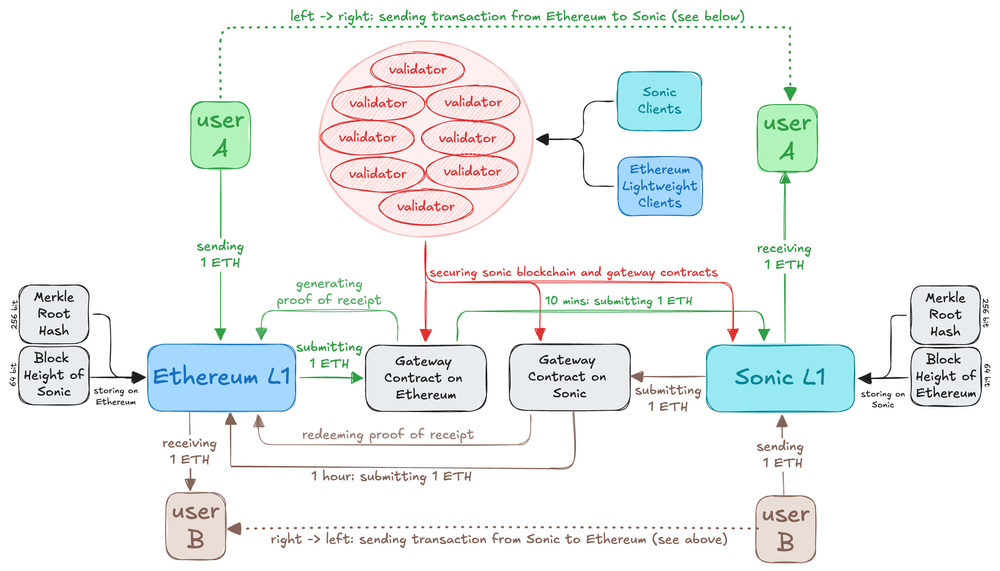
- The Sonic Gateway offers secure, trustless Ethereum-Sonic transfers, eliminating custody risks and providing full asset control.
- Sonic Labs integrates Chainlink and CCIP, empowering developers with secure tools for cross-chain application development.
Sonic Labs has taken another historic leap by introducing the Sonic Gateway, a decentralized and trustless bridge between Ethereum and its own network, Sonic. This new functionality solves one of the most significant concerns in the blockchain world: custody risks during cross-chain transfers.
Announcing the Sonic Gateway
#Sonic Gateway is a decentralized bridge between Ethereum and Sonic, eliminating all third-party and centralization risks.
With its fail-safe mechanism, the Gateway protects your assets under all circumstances.
https://t.co/zCGCvBMddj pic.twitter.com/HjaK0ZR8hh
— Sonic Labs (prev. Fantom)
(@0xSonicLabs) September 18, 2024
Enhanced Security and Full Asset Control with Sonic Gateway
With the Sonic Gateway, users no longer have to worry about losing control of their funds while transferring. The bridge uses Sonic’s validator network to provide secure ERC-20 token transfers, letting users retain complete control over their assets throughout the transaction.
Unlike other existing solutions that require a third party or middleman to manage assets during transfers, Sonic Gateway offers a trustless environment, dramatically lowering the possibility of hacking or mismanagement.
Transfers from Ethereum to Sonic take up to 10 minutes, while transfers from Sonic back to Ethereum might take up to an hour. Sonic Gateway stands apart with a fail-safe method, while appearing to be slower than comparable layer-2 solutions.

If the gateway fails for any reason and is inactive for 14 days, users can still access their Ethereum holdings. This provides an additional layer of security for people concerned about losing access to their funds.
Sonic Gateway has a significant advantage over other bridges in that it avoids the hazards associated with multi-signature bridge protection, which is a security issue for many Ethereum users. Multi-signature protection, while popular, has flaws that potentially expose user assets to hacking.
The Sonic Gateway, on the other hand, does not use this technique, making it speedier and more secure. Sonic, unlike layer-2 systems, which require a 7-day challenge period before finalization, provides faster transaction times without sacrificing security.
Sonic Labs has already reached key milestones in blockchain technology; therefore, the introduction of the Sonic Gateway is timely. CNF has revealed that Sonic achieved true transaction finality in 720 milliseconds, eliminating the requirement for additional block confirmations.
This innovation allows Sonic transactions to settle almost rapidly, which is a significant benefit for both developers and users.
Additionally, Sonic’s unique price structure incentivizes developers by paying them 90% of the gas fees, while customers benefit from fee-free transactions. This approach is likely to attract a larger developer community, fostering innovation in the Sonic ecosystem.
Beside that, as we previously noted, Sonic Labs has also improved its technology stack by including Chainlink Data Feeds and the Cross-Chain Interoperability Protocol (CCIP). This connection gives developers cutting-edge capabilities for creating safe, on-chain applications that can interface with several blockchains.
Chainlink’s decentralized oracle network and CCIP ensure that the data utilized in Sonic Labs’ ecosystem is reliable and safe. These technologies are critical for applications requiring precise data and smooth cross-chain functioning, making Sonic Labs a more robust and enticing platform for both developers and consumers.
At the time of writing, Sonic’s native token, FTM, is trading at $0.5689, up 2.64% over the last 24 hours. This bullish trend places FTM among the day’s top gainers.















